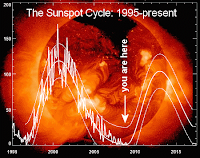Atlanta, Georgia - After Georgia was voted 8th worst winter in the Nation by the Weather Channel, the green house gas global warming theorists may have to go back to the drawing board.
This year Atlanta, Georgia experienced it's worst mind numbing winter since 1927.
In December of 2007, the Sun’s 11 year sun spot cycle 23 came to an abrupt halt and has failed kick start cycle 24. The last time the Sun acted in this way was during the Maunder Minimum of 1650, otherwise known as the little ice age.
"In our professional careers, we've never seen anything quite like it," says Dean Pesnell of the Goddard Space Flight Center. "Solar minimum has lasted far beyond the date we predicted in 2007."
Sun spots are like volcanoes on the surface of the Sun spewing solar flares that bombard the Earth.
Sun spots have 11 year cycles into 100 years, into 400 years and very well could be the main cause of Earth’s fluctuations in temperature since the beginning of time. The Sun can be viewed in real time from the National Solar observatory at www.nso.edu/current_images.html

The Weather channel reported 3.6 feet of snow in Georgia, from the record five total days it snowed this year. Jan. took the blunt of the 11 day cold streak with 10 to 19 degrees below average, turning Atlanta’s icy lakes into a hockey players dream.
On Jan. 16, Georgia Power had to call for backup from 2,200 additional crew workers for the 235,000 customers who lost power. Southern Company was at employee capacity with a crew of 3,500 strong.
So why are so many records being broken in the winter seasons if, Time Magazine’s article “Can we save the earth by 2015,” is claiming global warming is going to make earth to hot to inhabit?

In considering the sheer size of the Sun to the Earth, could it be possible Earth’s atmosphere is at the mercy of it’s star, not humans? With the millions of years of newly documented temperature data linking Sun and Earth cycles to global climate change, scientists are beginning to scratch their heads.
With ice ages occurring every 20,ooo years, 40,000, years and 100,000 years averaging a global temperature of 5 degrees Celsius, Earth is entering the Perseus dust cloud and is starting it's bigger 70,000 year cool down.
6000 years ago, the Earth finished its hottest 20,000 year cycle of an average temperature of 13 degrees Celsius. The Sun’s cooling cycle of 29,000 years is now in effect at an average temperature of 5 degrees Celsius.
Giving support to the Sun spot theory, Milutin Malankovitch claims Earth's temperatures are paralleled with the tilt of it's axis, affecting change in the reflection of the Sun's radiation raining on the Earth's magnetic field. Coincidentally, the Malankovitch temperature charts are paralleled with the oceanic temperature charts from deep-sea biomass cores drilled in the ocean, and the Vostok ice core data.
Astronomer Randi Lee says, “Earth’s orbit around the Sun is a major contributing factor to global climate change because of it’s elliptical orbit and axial tilt.”
The Malankovitch theory states global temperatures are affected by Earth's axial tilt, which is a slight movement of the Earth’s axis over a long period of time. The Earth's axis takes 26,000 years to complete a full wobble of it's axis from 24.5 degrees, to 22.1 degrees and back. Currently the Earth's axis is at 23.44 degrees and decreasing, moving into the cooler cycle of it’s axial tilt.
Some theorists like astronomer Theodore LaRosa from Kennesaw State University, believe the green house effect is the only cause of global warming, and any theory suggesting otherwise is preposterous. This theory weighs in a rather controversial debate when considering carbon dioxide (Co2) is a byproduct of fossil fuels, and humans breathing.
Fuel combustion and industrial processes, release 6.3 (ppmv) of Co2 per year making fossil fuels currently represent .00875% of the atmospheres Co2 concentration.
According to the Intergovernmental Panel on Climate Change, the atmosphere contains 730 parts per million of volume (ppmv) of Co2.
Co2 is not alone in Earth's atmosphere, for Co2 makes up .038% of the entire atmosphere which is composed of 78% nitrogen, 21% oxygen, and 0.93% argon.
120,000 years ago, the Vostok ice core reads Co2 concentrations in the atmosphere were exactly the same as they are today.
Unless dinosaurs and primative man were rollin' in their SUV's during the Pleistocene age, human induced global warming may be losing valor in the race for the “undeniable cause” of Earth's cyclic fever.
The data pertaining to global temperature patterns caused by the Sun's and the earth's orbit have been virtually ignored, however, these theories may explain recent and ancient cool winters Earth has been experiencing for the past half a million years.
The theories in this article point to the "chicken-or-the-egg" question, which one of these climate variables are systematically causing the other to occur. According to the Vostok ice core data, Co2 is lagging behind Earth's waves of temperature increase.







No comments:
Post a Comment